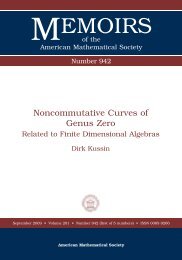University of Paderborn Department of Mathematics Diploma Thesis ...
University of Paderborn Department of Mathematics Diploma Thesis ...
University of Paderborn Department of Mathematics Diploma Thesis ...
You also want an ePaper? Increase the reach of your titles
YUMPU automatically turns print PDFs into web optimized ePapers that Google loves.
62 CHAPTER 3. OPERATIONS ON STABLE IDEALSTo take J to its double saturation, we have to contract the monomials x 0 , x 4 1x 3 2, x 4 1x 2 2x 3 3,x 4 1x 2 2x 2 3, x 4 1x 2 2x 3 , x 4 1x 2 2. Hence, we obtain the idealsJ (0) = (x 2 0, x 0 x 1 , x 0 x 2 , x 0 x 3 , x 5 1, x 4 1x 4 2, x 4 1x 3 2x 3 , x 4 1x 2 2x 4 3)J (1) = (x 0 , x 5 1, x 4 1x 4 2, x 4 1x 3 2x 3 , x 4 1x 2 2x 4 3)J (2) = (x 0 , x 5 1, x 4 1x 3 2, x 4 1x 2 2x 4 3)J (3) = (x 0 , x 5 1, x 4 1x 3 2, x 4 1x 2 2x 3 3)J (4) = (x 0 , x 5 1, x 4 1x 3 2, x 4 1x 2 2x 2 3)J (5) = (x 0 , x 5 1, x 4 1x 3 2, x 4 1x 2 2x 3 )J (6) = (x 0 , x 5 1, x 4 1x 3 2, x 4 1x 2 2) = sat x3 ,x 4(J)Since only the first two contractions are different in the process taking I to sat x3 ,x 4(I) andJ to sat x3 ,x 4(J), we proceed as follows: First we contract the monomial x 4 1x 2 2x 5 3 in I, whichprovides the ideal I (1) . Then we expand the monomial x 4 1x 3 2 in I (1) , which provides theideal(x 0 , x 5 1, x 4 1x 4 2, x 4 1x 3 2x 3 , x 4 1x 2 2x 5 3).Next, we contract the monomial x 4 1x 2 2x 4 3 and obtain(x 0 , x 5 1, x 4 1x 4 2, x 4 1x 3 2x 3 , x 4 1x 2 2x 4 3).The last step is the expansion <strong>of</strong> x 0 in this ideal, which provides(x 2 0, x 0 x 1 , x 0 x 2 , x 0 x 3 , x 5 1, x 4 1x 4 2, x 4 1x 3 2x 3 , x 4 1x 2 2x 4 3) = Jand we are done.In particular, the ideals I and J are linked by the contraction-expansion pairs x 4 1x 2 2x 5 3, x 4 1x 3 2and x 4 1x 2 2x 4 3, x 0 .Remark 3.31. Our aim is to prove the result <strong>of</strong> Proposition 3.28 for all saturated stableideals I, I ′ ⊂ R with the same double saturation and the same Hilbert polynomial. Theproblem is, we cannot assume in general that one <strong>of</strong> the ideals I, I ′ contains only onemonomial generator with the last variable x n−1 . This problem can be avoided, since wecan use one <strong>of</strong> the ideals, say I, to compute an ideal J (via a sequence <strong>of</strong> special contractionsfollowed by a sequence <strong>of</strong> special expansions) with the same double saturation and the sameHilbert polynomial as I, which contains only one minimal generator with the last variablex n−1 . The ideal J can be computed as follows: LetI =: I (0) , I (1) , . . . , I (j) = sat xn−1,xn (I)be the sequence <strong>of</strong> ideals obtained when taking I to sat xn−1 ,x n(I) by performing contractionsas in Lemma 3.17. Furthermore let Ĩ := I(i) , 0 ≤ i < j, be the first ideal <strong>of</strong> the abovesequence, which contains only one minimal monomial generator m with the last variable
















